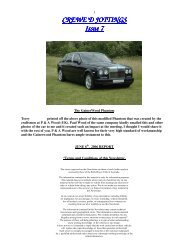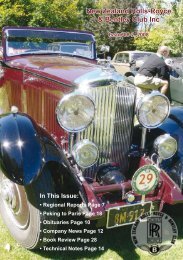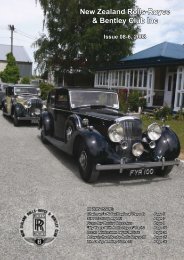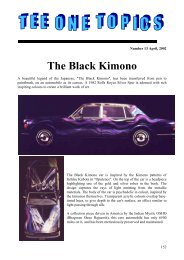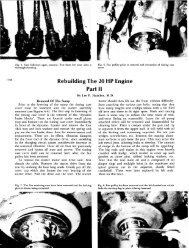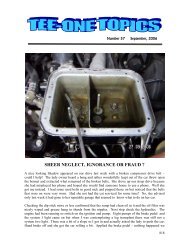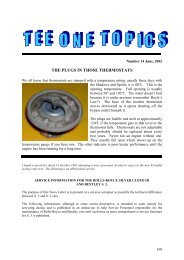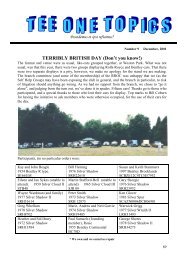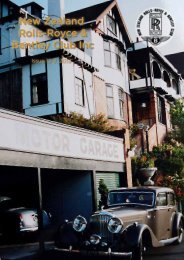Issue 34b - The Enthusiasts Website for Roll-Royce & Bentley Motor ...
Issue 34b - The Enthusiasts Website for Roll-Royce & Bentley Motor ...
Issue 34b - The Enthusiasts Website for Roll-Royce & Bentley Motor ...
You also want an ePaper? Increase the reach of your titles
YUMPU automatically turns print PDFs into web optimized ePapers that Google loves.
with these cars were about<br />
as much use as a bucket of<br />
glow worms. <strong>The</strong>y looked<br />
very elegant and are now<br />
impossible to replace.<br />
<strong>The</strong>re are I was horrified to<br />
note at the Centenary<br />
Rally, some of these cars<br />
getting around with<br />
original light fittings. <strong>The</strong><br />
above conversion using a<br />
standard 7 inch sealed<br />
beam light and an old<br />
Holden inner frame not<br />
only protects the original<br />
item but gives a far<br />
superior light. If you want to improve on that look to flat front sealed beams or semi sealed<br />
units with super dooper globes but watch the current draw and if necessary hide a relay<br />
somewhere <strong>for</strong> switching lest you burn up your beautiful light switch.<br />
<br />
REFINISHING WOODWORK<br />
(<strong>The</strong>se writings appeared on the Club website in response to someone enquiring about failing<br />
veneers particularly on SZ cars.) Lest it be lost I include it here <strong>for</strong> reference. <strong>The</strong> author<br />
‘Steve’ is unknown to me.)<br />
Most of the veneered wooden trim fitted to vehicles since the 60's has been of very poor quality,<br />
<strong>Roll</strong>s-<strong>Royce</strong> & <strong>Bentley</strong> however have continued to use the finest backing materials and<br />
adhesives and this in my experience makes it the easiest to restore of any manufacturer. <strong>The</strong><br />
only exception is the Camargue fascia where the veneers are bonded to aluminium, which<br />
causes particular difficulties during stripping. In answer to your question the lacquer used on<br />
your car was polyester and if memory serves correctly 1985 saw the introduction of an improved<br />
coating with a flex additive. This was better able to resist cracking and subsequent shelling.<br />
Prior to polyester, melamine materials were used but these would date back to the 1960’s.<br />
I would strongly suggest you do not sand the existing coatings. Apart from being time<br />
consuming the risk of breaking through the veneers is too high. <strong>The</strong> best method is to use a<br />
chemical paint remover however as the original coating is a flexible polyester and polyesters do<br />
not break down easily, go <strong>for</strong> a brand that has a reputation <strong>for</strong> being aggressive. If you plan on<br />
doing the entire wood set buy at least a 2.5 litre can.<br />
Be<strong>for</strong>e you do anything make notes or take photographs showing the location and colour of the<br />
painted in areas on the ends of the waist rails etc. You should also try and obtain at this stage a<br />
small amount of brown cellulose paint matched to the instrument apertures.<br />
Paint removers contain some pretty nasty chemicals so work in a well ventilated area and at the<br />
very least wear rubber gloves and use eye protection. Don't work in direct sunlight though as the<br />
stripper will dry out too quickly. To limit the amount of clearing up later lay down several<br />
thicknesses of a good quality paper, sufficient to do at least several pieces at a time. Tape up any<br />
492



